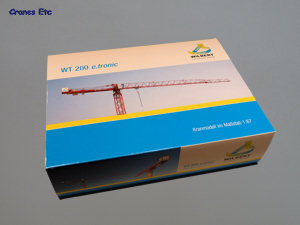 | | The Wilbert box. |  | 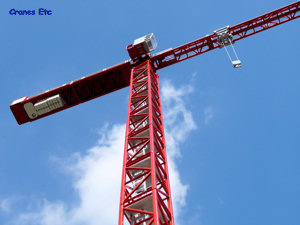 | | The push-fit pinned connections in the mast are tight enough to let the mast be set straight. | 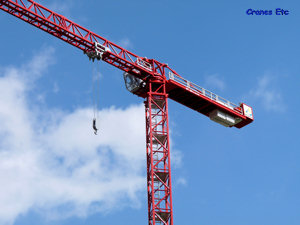 | | Overall profile is very convincing. | 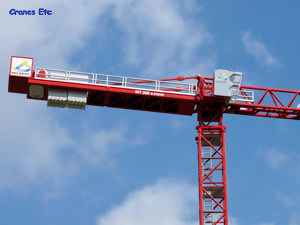 | | The counter jib. | 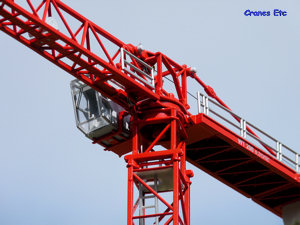 | | Close up of the cab area. | 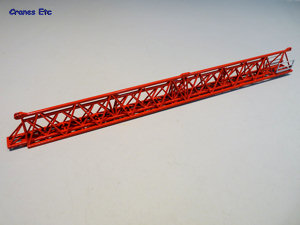 | | The ability to store one jib section inside another works perfectly on the model. | 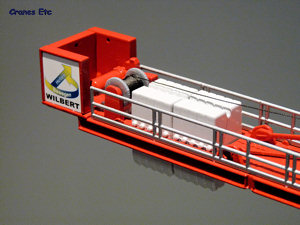 | | Advertising signs and motor at the rear. | 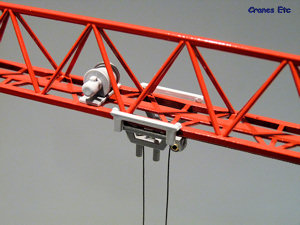 | | Trolley and trolley winch. |
| Wilbert is a German company which originally started out as a building contractor in 1932. Eventually specialising in crane hire, the company focussed on tower cranes from 1999 onwards and ran a tower crane rental fleet based heavily on machines supplied by Wolff. In 2003 a radical change was made with the first demonstration of a Wilbert Tower Crane. Since then a range of tower cranes has been developed and is in use, mainly in Europe.
The first Wilbert crane was the WT200. It is a topless tower crane and the main design principle used was to reduce the transport costs for the machine. This leads to the unusual stepped jib which means that the jib has two profiles and that the smaller one can slide inside the larger one to reduce transport. This means the entire upper part of the crane including a 60m jib can be transported on only two trucks.
The maximum jib length of the WT200 is 65m, at which radius it can lift 1.7t. The maximum capacity is 7.8t when the crane is rigged with a 30m jib.
Packaging
The model comes in pair of expanded polystyrene trays, which are held together with a picture sleeve. There were no defects or missing parts on the review model.
No instructions are included which is an omission as an inexperienced collector, or someone receiving the model as a corporate gift, would certainly appreciate some advice. With that said, the model is not difficult to build and it should be accomplished comfortably in less than an hour.
There is also no information on the real machine, which is a missed opportunity in terms of the promotional value of the model.
Detail
Wilbert has a close relationship with Wolff cranes and this is followed in the scale model too. The cruciform base and mast sections are the same castings as used in previous Wolff models (see 2017 and 2030) and so are very old castings. Having said that, the base is nicely cast in metal, and includes a textured surface at the base and a cable reel. Four plastic bogie assemblies have to be attached at the bottom and these have a good colour match, just lacking the gloss finish of the painted metal parts. Two ballast blocks are provided for the base and these are new castings which are made to appear as separate slabs with the Wilbert name contained within the casting.
The mast sections are cast in the height of two real sections and nicely represent the lattice work. They connect together using the push pin system and this generally provides a secure connection. Ladders and platforms are included and these are made in plastic. A clip-on capacity board is provided to attach to the mast.
The mast head comes in two parts, separated at the slewing ring. These are nicely made and include two slewing motors detailed within the casting. The operator's cab is a metal part except for the plastic windows which also have a windscreen wiper. The handrails also look convincing given the small scale.
The counter jib is modelled well as a single piece with strong lattice work on the underside, and a textured surface on the top. The handrails are metal and look fine. At the back, there are equipment cabinets and a winch motor, with Wilbert signs filling the place where advertising signs can be placed on the real crane. The counterweight is provided in two blocks and they are cast to appear to be made of separate concrete slabs like the original.
The main jib is made in three parts, and all are fully triangulated sections, and it appears to scale overall at a 60m length. The large inner section has a solid plate replicating the inner walkway as part of the casting, and the plastic trolley motor can also be fitted. The transition section of jib is a very well made complicated part, and the long outer section fits on. The manufacturing is top quality as the jib is exceptionally straight. The jib is also relatively heavy, and this means that when fully erected the model is not naturally in balance as although the counter jib is heavy, it is not heavy enough. This means that the jib tends to want to tilt down a little, so adding some extra weight at the back makes the model sit level. However with the ballast at the bottom of the mast there is no danger of the model tipping over. The jib sections are joined with small plastic pins which work fine but it would have looked better if they had been the same colour as the rest of the crane rather than grey.
The trolley is a plastic part and includes two tiny pulleys to carry the hoist ropes. The hook is metal and is just heavy enough to apply tension to the slightly stiff thread supplied pre-wound on the hoist drum by Conrad.
Features
The crane rotates easily and the hoist drum can be rotated by using a finger to raise and lower the hook.
The trolley can be manually set to any position on the jib although it does not traverse the transition point between the two different cross sections very easily.
The modular nature of the model means that it can be built to four different mast heights. However the way the main jib is made does not allow any different jib configurations to be built which is a pity as if it had been made of smaller components more flexibility would have resulted, although in turn perhaps the straightness of the jib would have suffered.
Quality
This is a good quality 1:87 tower crane model with a very high quality of manufacture from the engineering point of view and the jib is exceptionally straight. Most of the model is metal and the paintwork and graphics are very good.
Price
The model is relatively expensive compared to other recent 1:87 tower crane models and so is only fair value overall.
Overall
This crane has taken a long time to come to market after it was first seen as a prototype in 2007, and is the first new Conrad 1:87 tower crane for a few years. As usual the quality of the new castings is very good and the geometry of the jib is first rate. It would have been really good if the jib had been made of smaller sections so that a variety of jib configurations would have been possible. In summary, collectors of tower cranes will want this model and it is recommended.
Footnotes
The model first appeared as a prototype at the BAUMA Exhibition in 2007. Bulk deliveries to dealers commenced in March 2009.
|
| |
| 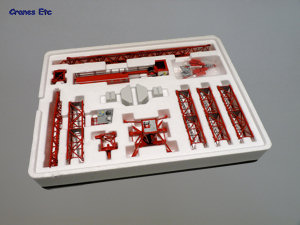 | | Inside the box. | 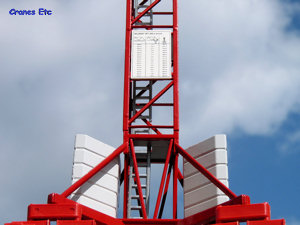 | | Base, including the clip-on capacity board. | 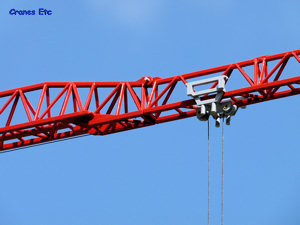 | | The complicated section where the jib changes. | 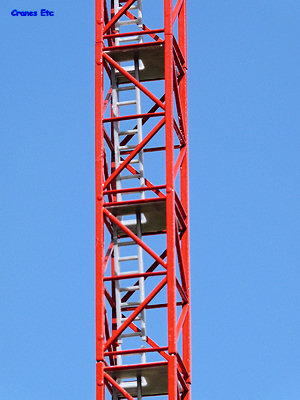 | | Mast sections with ladder inserts. | 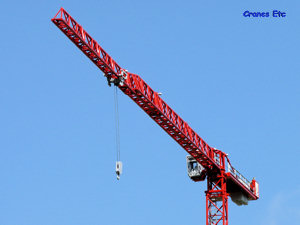 | | A very realistic model. | 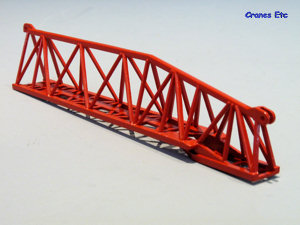 | | A very complicated piece of diecasting. | 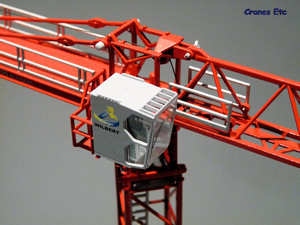 | | Very nice metal cab. | 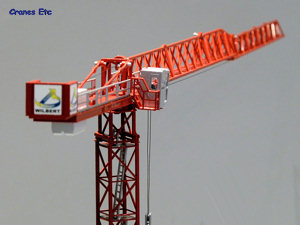 | | Very good geometry of the jibs. |
|

